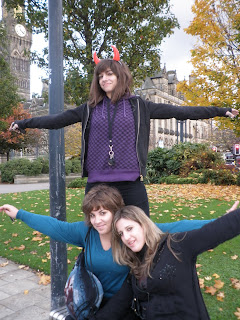Scene 16
Ext. Night, out side building.
A car arrives, Eleni says goodbye to her boyfriend when she is getting out of the car.
Melanie: Bye, babe! See you tomorrow!
He drives off
Melanie walks to the building and enters it. It is deathly quite. The lights are off, she presses the elevator button. Her phone starts to ring. Melanie looks around.
Next shot – Melanie coming out of the elevator then walks down empty hall.
Melanie's phone starts to call and she picks it up. Nobody talks to her so she hangs up but the phone starts to ring again.
When Melanie picks it up this time there are some freaky noises.
She gets another dodgy phone call. She doesn’t pick it up and it keeps ringing. When it stops Melanie tries to call her boyfriend but there is no signal.
Melanie: Bugger!
She gets scared and walks faster. When Melanie reaches the kitchen she opens the door and Santa comes out at the same time. Melanie screams, Santa freaks at first but then starts to laugh. Melanie understands that it is only Santa.
Melanie: Aggh... you bitch! You scared me half to death!
Joanna: You shouldn’t be so odd then.
Melanie: I hate you
Joanna: So how was the party?
Melanie: Freaking dynamite!
Joanna: I am going to bed because you smell like a tramp.
Joanna walks off.
Melanie looks at Joanna nasty and walks to her room, unlocks the door. Melanie opens the door and notices that her window is open and curtains are moving in the wind. She turns on the light and closes the window.
Melanie takes off her shoes and suddenly someone grabs her from behind covering her mouth.
Scene finished!!
















